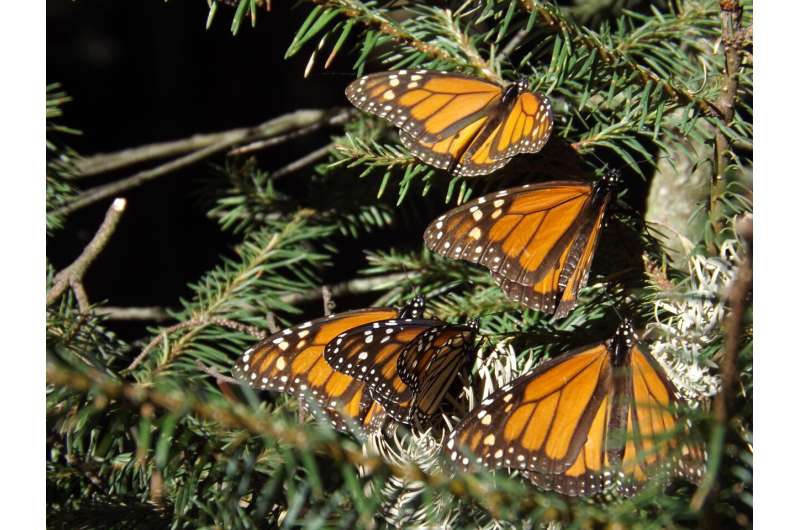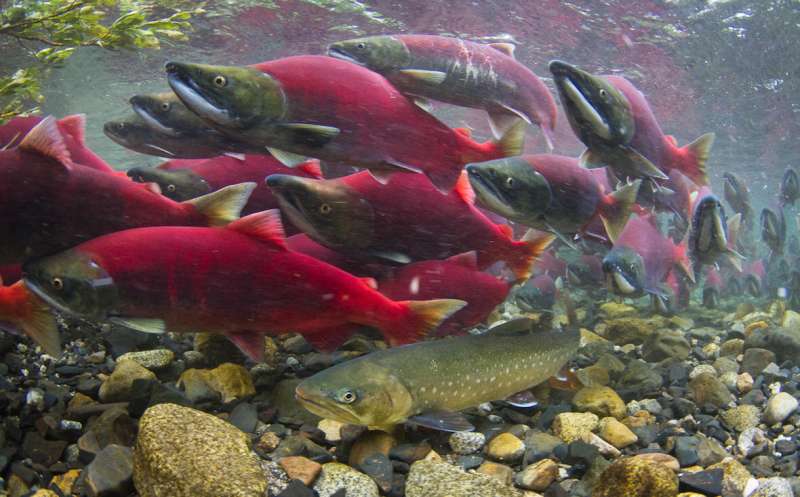Traveling with friends helps even mixed-up migrators find their way

Some of us live and die by our phone's GPS. But if we can't get a signal or lose battery power, we get lost on our way to the grocery store.
Yet animals can find their way across vast distances with amazing accuracy.
Take monarch butterflies, for example. Millions of them fly up to 2,500 miles across the eastern half of North America to the same overwintering grounds each year, using the Earth's magnetic field to help them reach a small region in central Mexico that's about the size of Disney World.
Or sockeye salmon: starting out in the open ocean they head home each year to spawn. Using geomagnetic cues they manage to identify their home stream from among thousands of possibilities, often returning to within feet of their birthplace.
Now, new research offers clues to how migrating animals get to where they need to go, even when they lose the signal or their inner compass leads them astray. The key, said Duke Ph.D. student Jesse Granger: "they can get there faster and more efficiently if they travel with a friend."
Many animals can sense the Earth's magnetic field and use it as a compass. What has puzzled scientists, Granger said, is the magnetic sense is not fail-safe. These signals coming from the planet's molten core are subtle at the surface. Phenomena such as solar storms and man-made electromagnetic noise can disrupt them or drown them out.
It's as if the 'needle' of their inner compass sometimes gets thrown off or points in random directions, making it hard to get a reliable reading. How do some animals manage to chart a course with such a noisy sensory system and still get it right?
"This is the question that keeps me up at night," said Granger, who did the work with her adviser, Duke Biology Professor Sönke Johnsen.
Multiple hypotheses have been put forward to explain how they do it. Perhaps, some scientists say, migrating animals average multiple measurements taken over time to get more accurate information.
Or maybe they switch from consulting their magnetic compass to using other ways of navigating as they near the end of their journey—such as smell, or landmarks—to narrow in on their goal.
In a paper published Nov. 16 in the journal Proceedings of the Royal Society B, the Duke team wanted to pit these ideas against a third possibility: That some animals still manage to find their way, even when their compass readings are unreliable, simply by sticking together.

To test the idea, they created a computer model to simulate virtual groups of migrating animals, and analyzed how different navigation tactics affected their performance.
The animals in the model begin their journey spread out over a wide area, encountering others along the route. The direction an animal takes at each step along the way is a balance between two competing impulses: to band together and stay with the group, or to head towards a specific destination, but with some degree of error in finding their bearings.
The scientists found that, even when the simulated animals started to make more mistakes in reading their magnetic map, the ones that stuck with their neighbors still reached their destination, whereas those that didn't care about staying together didn't make it.
"We showed that animals are better at navigating in a group than they are at navigating alone," Granger said.
Even when their magnetic compass veered them off course, more than 70% of animals in the model still made it home, simply by joining with others and following their lead. Other ways of compensating didn't measure up, or would need to guide them perfectly for most of the journey to accomplish the same feat.
But the strategy breaks down when species decline in number, the researchers found. The team showed that animals who need friends to find their way are more likely to get lost when their population shrinks below a certain density.
"If the population density starts dropping, it takes them longer and longer along their migratory route before they find anyone else," Granger said.
Previous studies have made similar predictions, but the Duke team's model could help future researchers quantify the effect for different species. In some runs of the model, for example, they found that if a hypothetical population dropped by 50%—akin to what monarchs have experienced in the last decade, and some salmon in the last century—37% fewer of the remaining individuals would make it to their destination.
"This may be an underappreciated aspect of concern when studying population loss," Granger said.
More information: Jesse Granger et al, Collective movement as a solution to noisy navigation and its vulnerability to population loss, Proceedings of the Royal Society B: Biological Sciences (2022). DOI: 10.1098/rspb.2022.1910
Journal information: Proceedings of the Royal Society B
Provided by Duke University



















